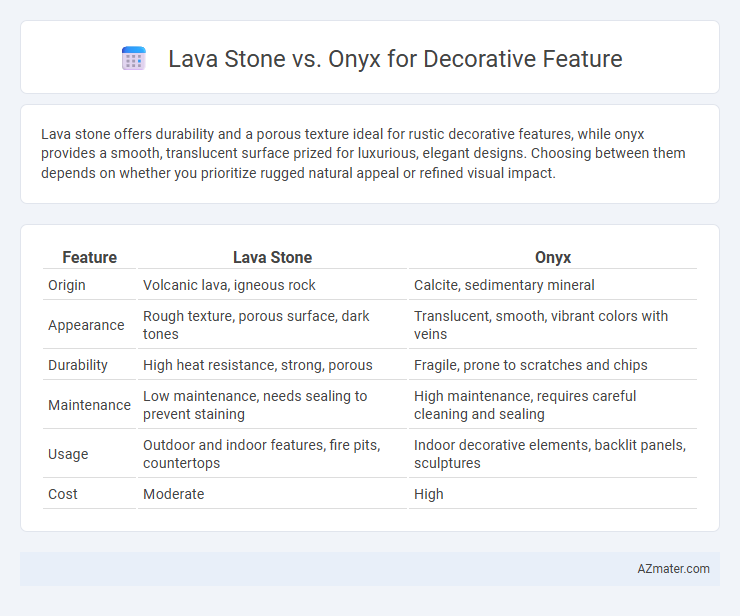Lava stone offers durability and a porous texture ideal for rustic decorative features, while onyx provides a smooth, translucent surface prized for luxurious, elegant designs. Choosing between them depends on whether you prioritize rugged natural appeal or refined visual impact.
Table of Comparison
| Feature | Lava Stone | Onyx |
|---|---|---|
| Origin | Volcanic lava, igneous rock | Calcite, sedimentary mineral |
| Appearance | Rough texture, porous surface, dark tones | Translucent, smooth, vibrant colors with veins |
| Durability | High heat resistance, strong, porous | Fragile, prone to scratches and chips |
| Maintenance | Low maintenance, needs sealing to prevent staining | High maintenance, requires careful cleaning and sealing |
| Usage | Outdoor and indoor features, fire pits, countertops | Indoor decorative elements, backlit panels, sculptures |
| Cost | Moderate | High |
Introduction to Lava Stone and Onyx
Lava stone, a porous volcanic rock formed from cooled molten lava, offers durability and a rustic, textured appearance ideal for decorative features with natural charm. Onyx, a translucent and banded carbonate mineral, provides exquisite elegance with its smooth surface and vibrant color patterns, often used to create striking visual impact in interior design. Both materials serve distinct aesthetic and functional purposes, with lava stone favored for rugged, earthy designs and onyx chosen for sophisticated, luminous accents.
Origin and Formation of Lava Stone vs Onyx
Lava stone, formed from the rapid cooling of molten lava during volcanic eruptions, originates primarily from volcanic regions such as Hawaii and Italy, possessing a porous texture and dark coloration. Onyx, a variety of chalcedony quartz, develops through the slow precipitation of silica-rich solutions in limestone caves, found commonly in countries like Mexico, Brazil, and Pakistan, exhibiting translucent bands in colors ranging from white to black. The contrasting geological processes yield lava stone's rugged durability and volcanic aesthetic, while onyx offers smooth, polished elegance ideal for decorative features.
Distinctive Visual Characteristics
Lava stone features a porous texture with a rugged matte finish, offering earthy, volcanic tones in dark gray to black that create a bold, natural aesthetic for decorative features. Onyx displays a smooth, translucent surface with intricate veining in warm hues like amber, white, and green, providing a luxurious and elegant appearance. The contrast lies in lava stone's raw, tactile quality versus onyx's polished, glowing translucency, making each material uniquely suited for distinct visual impact in interior design.
Durability and Strength Comparison
Lava stone exhibits exceptional durability with a high resistance to heat, scratches, and impact, making it ideal for heavy-use decorative features. Onyx, while visually stunning due to its translucence and unique veining, is softer and more prone to scratching and chipping, requiring careful handling and maintenance. For long-lasting strength in decorative applications, lava stone outperforms onyx in terms of toughness and resilience.
Color Range and Aesthetic Appeal
Lava stone offers a rich palette of deep blacks, grays, and earthy reds, lending a raw, natural texture ideal for rustic or industrial decorative features. Onyx, prized for its translucent qualities, showcases a vibrant spectrum of whites, greens, oranges, and golds, creating an elegant and luxurious aesthetic that enhances ambient light. The choice between lava stone and onyx depends on desired color range and visual impact, with lava stone emphasizing rugged warmth and onyx highlighting luminous sophistication.
Maintenance and Care Requirements
Lava stone requires minimal maintenance due to its porous nature; it should be sealed regularly to prevent staining and cleaned with a mild detergent to preserve its textured surface. Onyx, being a softer and more delicate natural stone, demands more careful upkeep, including periodic sealing and avoiding acidic or abrasive cleaners to prevent etching and discoloration. Both materials benefit from prompt spill cleanup and routine dusting to maintain their decorative appeal and longevity.
Popular Decorative Uses in Interior Design
Lava stone and Onyx are popular choices for decorative features in interior design due to their unique aesthetic qualities. Lava stone's porous texture and matte finish make it ideal for rustic wall cladding, fireplace surrounds, and accent pieces that add natural earthiness. Onyx, renowned for its translucency and vibrant veining, is frequently used in backlit countertops, feature walls, and luxury tabletops to create striking, luminous focal points.
Cost Differences and Value Considerations
Lava stone typically costs less than Onyx due to its abundant availability and lower extraction complexity, making it an economical choice for large-scale decorative features. Onyx, valued for its translucent quality and unique veining, commands higher prices that reflect its rarity and artisanal appeal. When considering value, Onyx offers a luxurious aesthetic that can significantly elevate interior spaces, whereas lava stone prioritizes durability and budget-friendly versatility.
Environmental Impact and Sustainability
Lava stone is a highly sustainable choice for decorative features due to its natural abundance, low extraction impact, and durability that reduces the need for frequent replacement. Onyx, while visually striking, involves more intensive mining processes and higher energy consumption, contributing to greater environmental degradation. Choosing lava stone promotes eco-friendly design by minimizing carbon footprint and supporting long-term sustainability in interior and exterior applications.
Choosing the Best Stone for Your Decorative Feature
Lava stone offers a rugged, porous texture and high durability, making it ideal for outdoor decorative features that require weather resistance and natural aesthetics. Onyx boasts a translucent, polished surface with vibrant color variations, perfect for indoor settings where elegance and light diffusion enhance visual appeal. Selecting the best stone depends on the environment and desired look: opt for lava stone for rustic, durable applications and choose onyx for striking, luxurious indoor features.

Infographic: Lava stone vs Onyx for Decorative Feature
 azmater.com
azmater.com